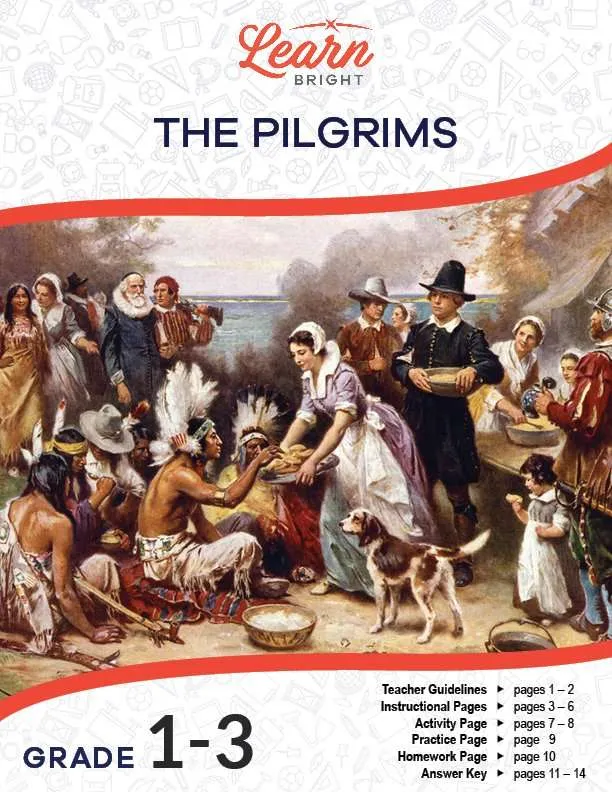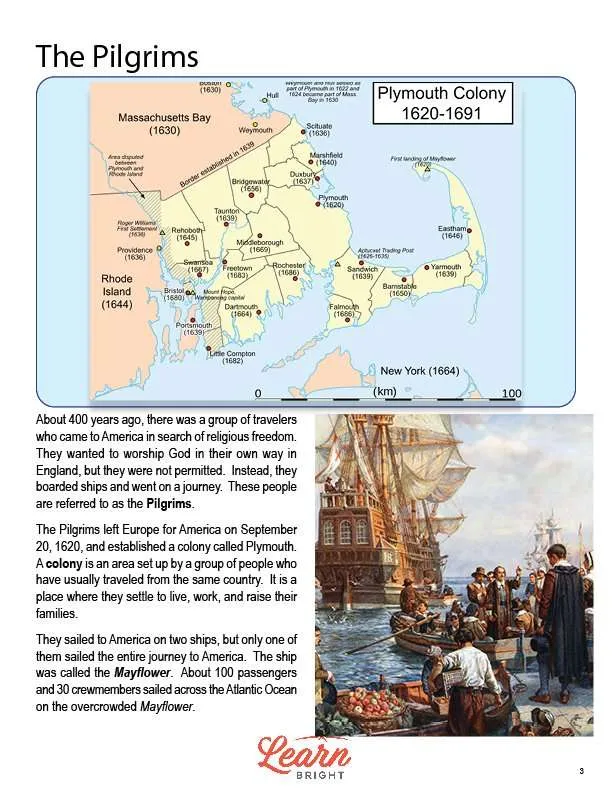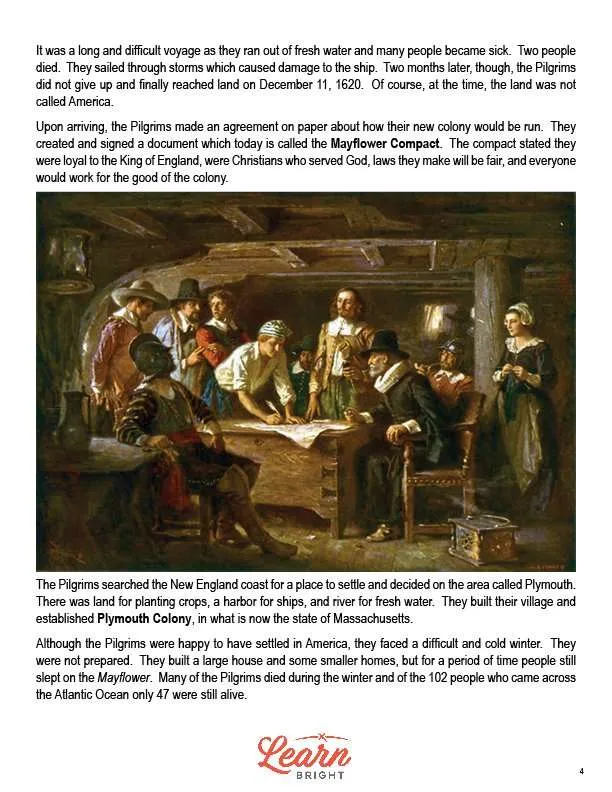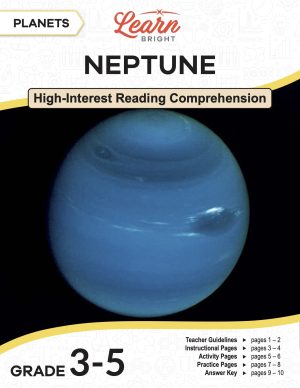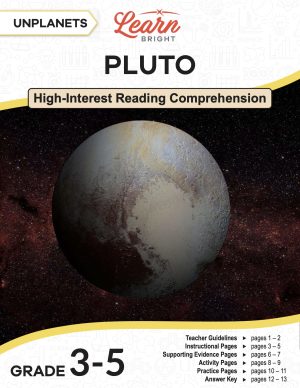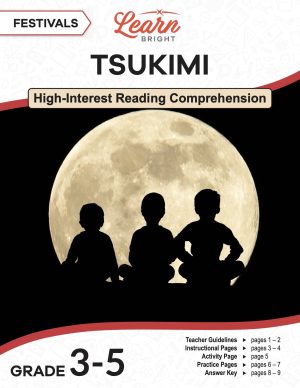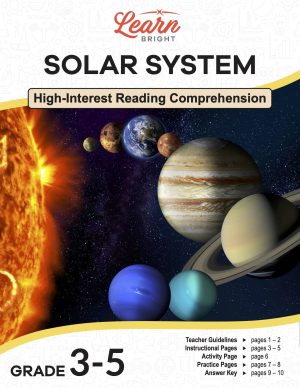Description
What our Pilgrims lesson plan includes
Lesson Objectives and Overview: Pilgrims teaches students about the earliest group of settlers in America. During this lesson, students will learn about the ships that the Pilgrims used to cross the Atlantic Ocean and why they left Europe. They will also discover facts about their relationship with the Native Americans who lived on the land the Pilgrims settled on. This lesson is for students in the 1st grade, 2nd grade, and 3rd grade.
Classroom Procedure
Every lesson plan provides you with a classroom procedure page that outlines a step-by-step guide to follow. You do not have to follow the guide exactly. The guide helps you organize the lesson and details when to hand out worksheets. It also lists information in the yellow box that you might find useful. You will find the lesson objectives, state standards, and number of class sessions the lesson should take to complete in this area. In addition, it describes the supplies you will need as well as what and how you need to prepare beforehand. For this lesson, you will need colored pencils and the handouts.
Options for Lesson
Included with this lesson is an “Options for Lesson” section that lists a number of suggestions for activities to add to the lesson or substitutions for the ones already in the lesson. For the Pilgrims lesson plan, these options include allowing students to draw pictures related to the pilgrims instead of just coloring them in, showing a video for the end of the lesson, or bringing in food for students to share as a part of the conclusion of the lesson. You could also teach this lesson during Thanksgiving, and expand on it with other Thanksgiving-themed activities. Students can also make Pilgrims hats or make a replica of the Mayflower using craft sticks or toothpicks.
Teacher Notes
The teacher notes page includes a paragraph with additional guidelines and things to think about as you begin to plan your lesson. This paragraph suggests additional lesson plans to pair with this lesson, and describes some of the additional resources that you can use to go along with this lesson. There is also ample space for you to add your own notes about the lesson.
PILGRIMS LESSON PLAN CONTENT PAGES
The Pilgrims
The Pilgrims lesson plan includes four content pages. The first few pages describe the history of the Pilgrims and how a group of them came to settle in America. Students will learn what a colony is and about the voyage that ships like the Mayflower took across the Atlantic Ocean during this time. They will learn that this specific group of people left Europe for America in search of religious freedom, as they were persecuted for their beliefs at home. They began their journey in September of 1620 and finally arrived in December.
Upon arriving, the Pilgrims made an agreement on paper about how their new colony would be run. They created and signed a document that today is called the Mayflower Compact. The compact stated they were loyal to the King of England and were Christians who served God. It also listed laws they would make that were fair and stated that everyone would work for the good of the colony.
The Pilgrims searched the New England coast for a place to settle and decided on the area called Plymouth. There was land for planting crops, a harbor for ships, and a river for fresh water. They built their village and established Plymouth Colony in what is now the state of Massachusetts. Although they were happy to have settled in America, they faced a difficult and cold winter for which they were not prepared. They built a large house and some smaller homes, but for a period of time, people still slept on the Mayflower. Many of the Pilgrims died during the winter. Of the 102 people who came across the Atlantic Ocean, only 47 were still alive.
Relations with the Native Americans
Native Americans lived in the same area as the Pilgrims. They were the people who were already living on the land before the Pilgrims arrived in what is now known as America. They established a peace treaty with the Pilgrims and also agreed to trade for animal furs. Some of the Native Americans also chose to stay with the Pilgrims and taught them how to plant corn, hunt, and fish, as well as how to survive the cold winter.
After the first harvest in 1621, the Pilgrims invited some of the Native Americans to join them for a feast. Sometimes this is referred to as the first Thanksgiving as the tradition continued after every harvest in the years that followed.
Life for the Pilgrims
The final section of the content pages describes what life was like for the Pilgrims. It explains what their homes were made out of, what they ate, how their villages were structured, and what work they had to do on a daily basis. Houses were made of timber frames and were simple structures with a main living room and a loft for sleeping in. Their villages were made up of homes with additional space for livestock and crops.
The clothes that they wore were made by hand and dyed using natural dyes made from plants, animals, and minerals. The Pilgrims mostly ate duck, seafood, mussels, cornbread, and oatmeal, which they all ate with their hands as they did not have utensils at this time. Work included planting and harvesting crops, hunting, turning grain into flour, and collecting water.
Students will learn that life was not easy for the Pilgrims but that their struggle was worth it so that they could freely practice their religion. This period of time marked the beginning of the United States of America as we know it today. The country grew from this settlement, into the 13 colonies, and then into the 50 states we have today.
PILGRIMS LESSON PLAN WORKSHEETS
The Pilgrims lesson plan includes three worksheets: an activity worksheet, a practice worksheet, and a homework assignment. Each one will help reinforce the concepts from the lesson and improve students’ understanding. You can refer to the guide on the classroom procedure page to determine when to hand out each worksheet.
PILGRIMS ACTIVITY WORKSHEET
For the activity pages, students will fill in the blanks in statements about the pilgrims. They will color in the Pilgrim-related pictures, like a cornucopia and a Pilgrim hat. An idea in the Options for Lesson section suggests having students draw their own pictures in addition to coloring the ones on this page.
MATCHING PRACTICE WORKSHEET
Students will match statements about the Pilgrims with their correct terms. These terms include the Mayflower Compact, Plymouth Colony, and Thanksgiving. They also include important dates and numbers, like 1620 and 102, the number of people who left England to sail for America. This worksheet will test students’ grasp of the important terms and dates explored in this lesson.
QUESTION AND ANSWER HOMEWORK ASSIGNMENT
For the homework assignment, students will answer questions about the Pilgrims. These questions ask about the things they did in their homes, some things that are located in their villages, what food they ate, and how the children of this time learned to read and write. Students will demonstrate their understanding of the lesson material with this homework assignment.
Worksheet Answer Keys
This lesson includes answer keys for the activity worksheet, practice worksheet, and homework assignment. The correct answers are in red to make it easy for you to compare them to your students’ work. If you choose to administer the lesson pages to your students via PDF, you will need to save a new file that omits these pages. Otherwise, you can simply print out the applicable pages and keep these as reference for yourself when grading assignments.

